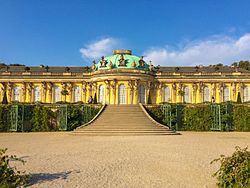From top to bottom: Sanssouci Palace in Germany, Catherine Palace in Russia, and Hermitage Retreat Building in Catherine Park in Russia | |
| Years active | 18th century |
|---|---|
| Location | Europe |
Rococo architecture, prevalent during the reign of Louis XV in France from 1715 to 1774, is an exceptionally ornamental and exuberant architectural style characterized by the use of rocaille motifs such as shells, curves, mascarons, arabesques, and other classical elements. The Rococo style abandoned the symmetry of earlier Baroque styles like façades, cornices, and pediments, and instead created a flexible and visually engaging style that maintained a level of classical regularity.[1] Light pastel colors, including shades of blue, green, and pink, replaced the darker elements characteristic of Baroque architecture such as exposed limestone and extensive gilding.[2]
The iconography of Rococo architecture, predominantly associated with 18-century Europe, had a considerable influence on various architectural styles globally over subsequent centuries. These styles include Dutch colonial, French colonial, Neoclassical, Greek Revival, Belle Époque, Second Empire, Victorian, Art Deco, and Art Nouveau.[3]
Some of the largest and most well known examples of Rococo architecture include royal palaces and other grand residences, such as Nymphenburg Palace and Sanssouci Palace in Germany, along with Runsa and Salsta Palaces in Stockholm, Sweden. In Russia, notable examples include Alexander Palace, Catherine Palace, and the Winter Palace.[4] Many have been preserved and serve as historic house museums.[5]
- ^ "The Rococo style – an introduction · V&A". Victoria and Albert Museum.
- ^ "The Rise of Pastel in the Eighteenth Century". The Metropolitan Museum of Art.
- ^ "The Exuberant and Ornate Style of Rococo: An Exploration of 18th-Century Art and Design". www.madridacademyofart.com. December 22, 2021.
- ^ Pinna, Geovanni (2001). “Introduction to Historic House Museums” Museum International.
- ^ Chateau de Versailles (2023). “Preventative Conservation in Historic Houses and Palace Museums: Assessment Methodologies and Applications”


